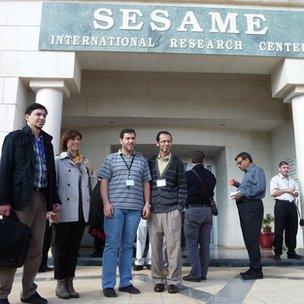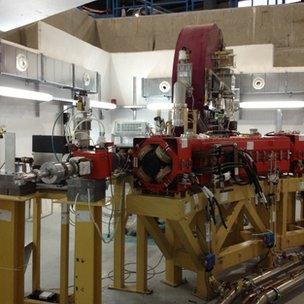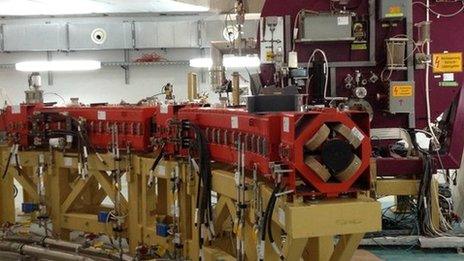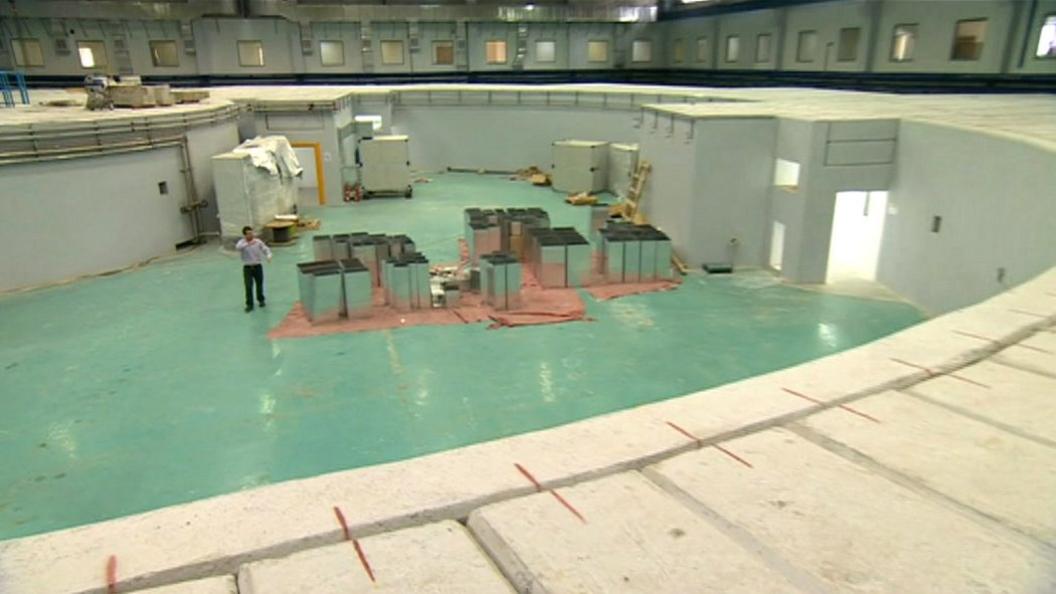Open Sesame: science surviving against all the odds
- Published
- comments

A model of collaboration
News that Middle Eastern adversaries are jointly building an advanced research centre has generated a mix of incredulity and optimism.
My story about the Sesame project appeared on Monday.
The incredulity comes from the fact that the endeavour is supported by Arabs, Turks, Iranians and Israelis.
Not only are these people meeting, calmly and productively, but also their governments are contributing large amounts of money for the construction of the synchrotron light source in Jordan which they will all share.
Against all the odds, the project is going ahead and the first research is scheduled for 2015.
The optimism is because the scientists from these different nationalities are getting along and somehow managing to leave conflict and politics at the lab door.
A typical reaction has been one of relief that at a time of rising tension in the region it is still possible for people to reach across barriers and enjoy a dialogue.
One comment posted on my blog about Sesame said simply: "This helps me recover some faith in humanity. Learn from this guys, this is how our world should be!"
But for many scientists this initiative is not surprising. They have long been proud of the ability of science to serve as a common language and Sesame shows that this idea is not a cliché but a reality.
I saw for myself how people from countries that do not recognize each other diplomatically, or even threaten to destroy or go to war with each other, can sit in the same seminar or chat amiably in the coffee breaks.
This is why the project attracted early support from the UN cultural and scientific agency UNESCO, external.
Science Golden Age
Interestingly though, this is nothing new to the Middle East. A key feature of the Golden Age of Islamic Science, when research flourished from the 9th to 15 centuries, was that it too ignored boundaries of religion and race.
The science was hosted by the Muslim leaders of the time but Christian and Jewish researchers were encouraged to be part of this era of inquiry and exploration.
More recently, in the Cold War, scientists reached out across the Iron Curtain in an effort to talk and lessen tensions.
The motivation back then was to reduce the risk of nuclear war. In 1955 Bertrand Russell and Albert Einstein issued a now-famous statement appealing for calm:
"Here then is the problem which we present to you. Stark and dreadful and inescapable: Shall we put an end to the human race; or shall mankind renounce war?"
That led to a meeting in 1957 in the Canadian village of Pugwash which brought together British, American and Soviet scientists to discuss ridding the world of nuclear weapons.
Some critics at the time said the Pugwash conferences , externalwere overly idealistic and one could argue over whether they had any influence over the events that led to the end of the Cold War.
But the movement and one of its founders, Professor Joseph Rotblat, were eventually awarded the Nobel Peace Prize in 1995.
And as we reported, the model for Sesame is CERN, external, the European research centre set up in Geneva to unite scientists from countries that had been fighting each other in the Second World war.
Long way to go
To spread the 'CERN effect', the lab is now providing some of Sesame's key components - the magnets for the main 'storage ring' - with the EU picking up the $5m bill.
Sesame is having to endure far more troubled waters than CERN did; it's experiencing tensions more similar to those faced by the Pugwash pioneers so, if it succeeds, it too may be in the running for Nobel honour.
But it has a long way to go yet.
Between visiting the Sesame site, and publishing our stories about the project, the conflict between Israel and Hamas in Gaza erupted. Rockets and air strikes claimed the lives of six Israelis and more than 100 Palestinians.

The facility is full of hi-tech equipment
I kept checking but this violence did not derail Sesame, as one might have expected. The motivation for those taking part - to have access to a sophisticated synchrotron - must outweigh any diplomatic unease.
One leading Jordanian scientist, who is not involved in the project, did tell me that she could not imagine meeting any Israeli scientists unless they denounced their government's actions.
If the researchers were getting together in a spirit of common humanity, she said, that humanity would require a basic statement condemning the air strikes.
But if that sentiment is felt by any of those taking part in Sesame, there has been no sign of it so far. Officially at least no scientist or government has suggested pulling out.
Key test
The key test will be next summer when the Sesame Council is due to meet again. This is where government representatives turn up and debate the strategic issues like funding.
At the meeting earlier this month, all the key countries were there except for the delegate from Bahrain was absent - which may or may not indicate that country's degree of support, even before the Gaza conflict.
A greater threat lies in the risk of war between Iran and Israel. The president of the Sesame Council, Prof Sir Chris Llewellyn Smith, told me that a major conflict would "stop us in our tracks".
In that extreme scenario, it would presumably be politically impossible for Iranians and Israelis to meet, and travel would probably be too dangerous.
A few of those involved in Sesame feel I focused too heavily on the participation of Iran and Israel - that the presence of Turkey and Cyprus was equally interesting and that singling out particular countries would draw unwelcome attention to people who might face criticism back home.
I understand the concern and in our filming we were very mindful of the need to tread carefully. It's one thing for certain nationalities to be filmed together in the formal setting of a conference, quite another to be seen being friendly.
Yet this is what Sesame is all about: creating a unique forum for exchange and it needs publicity to help secure more funding and political support.
The minefield surrounding the project is what makes it fascinating and newsworthy:
how Iran can continue participating despite the difficulties of coping with international sanctions;
how Israel can take part when Iran is accused of supplying Hamas with missiles;
whether the United States can ever support Sesame with Iran as a participant;
whether the richest Arab states, notably Saudi Arabia, which are investing massively research, will ever be able to overlook Israel's participation;
whether Jordan, facing a surge in unrest in the past fortnight, will remain stable enough to host the facility.
Covering this story often made me wonder if I was being naïve about Sesame's chances.
But on the day of broadcast, I received a Tweet saying "this is how the world is meant to be". Maybe, occasionally, a little optimism is justified.
- Published26 November 2012

- Published26 November 2012
- Published26 November 2012
